




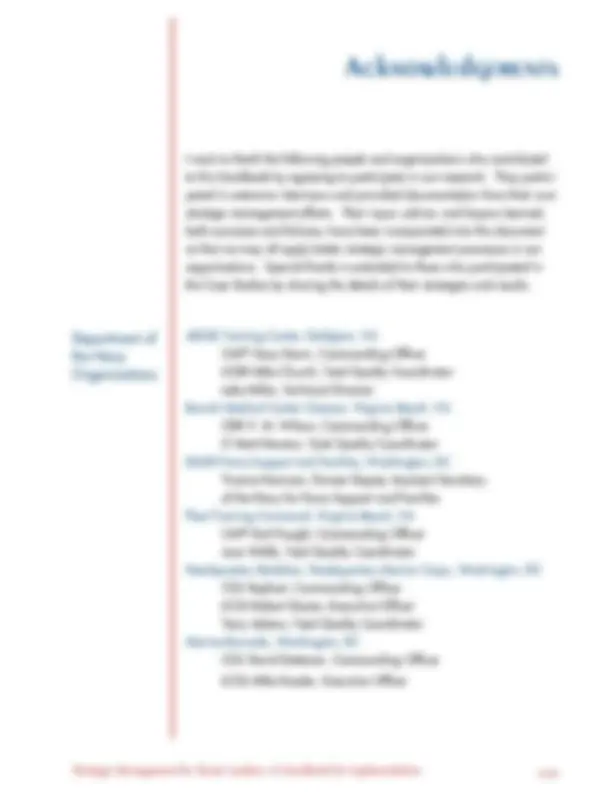

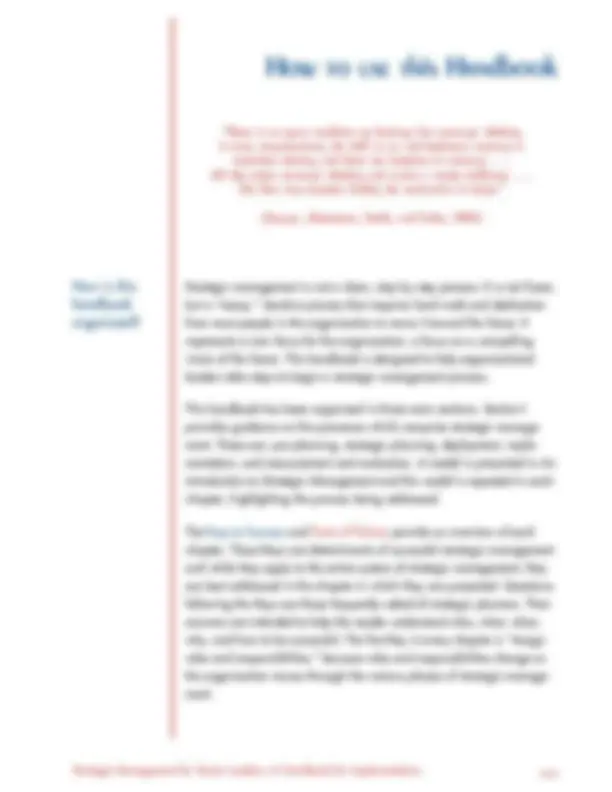
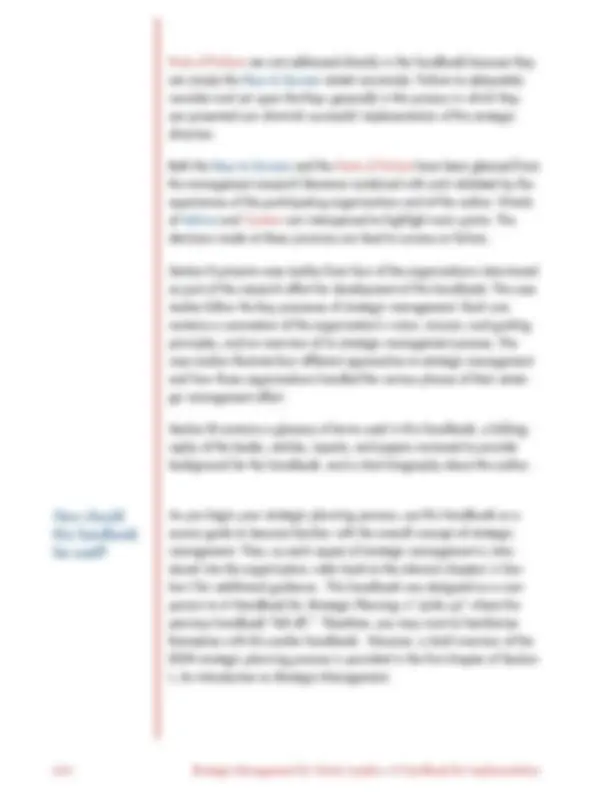

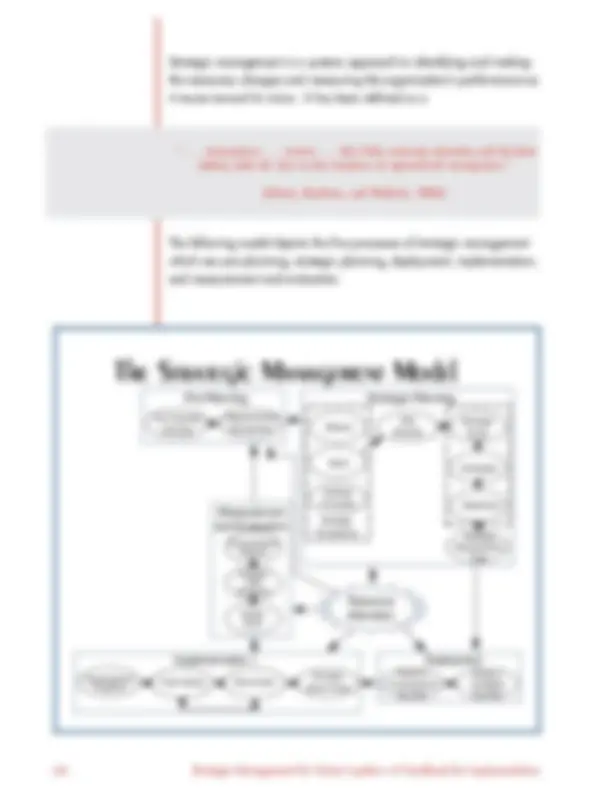
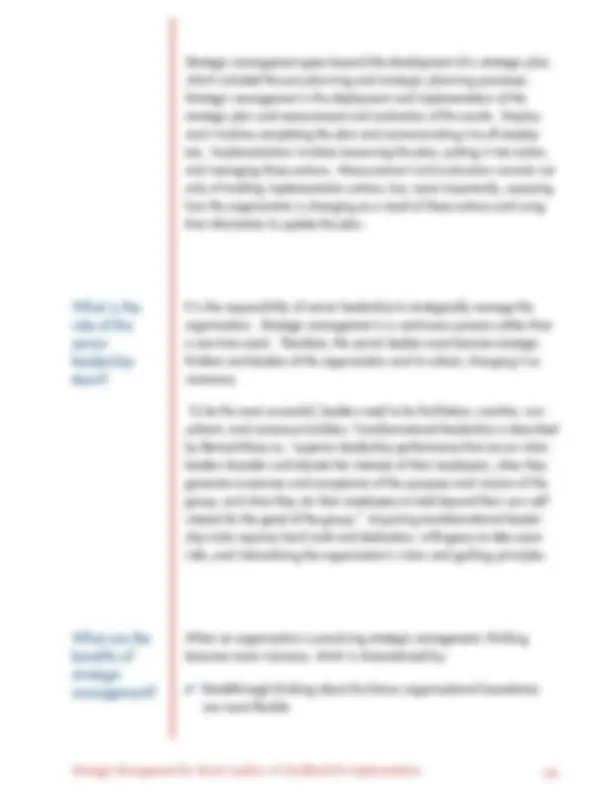
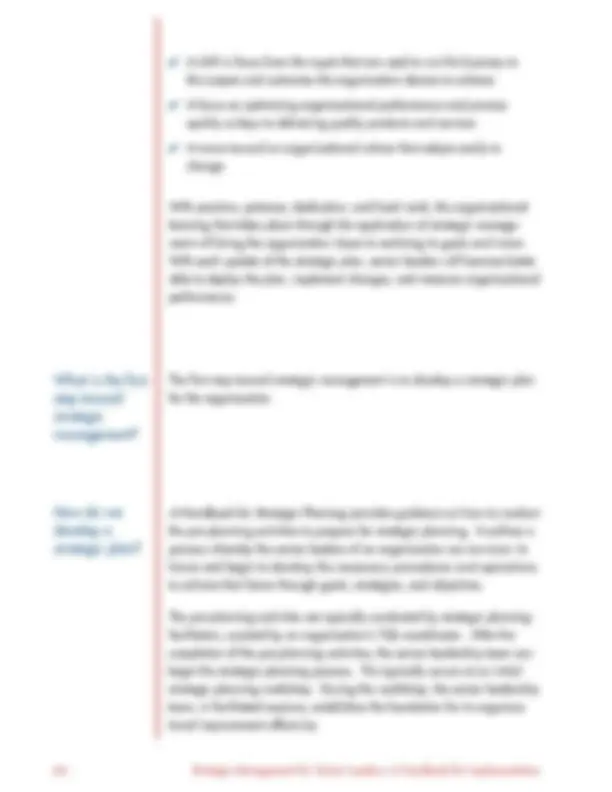
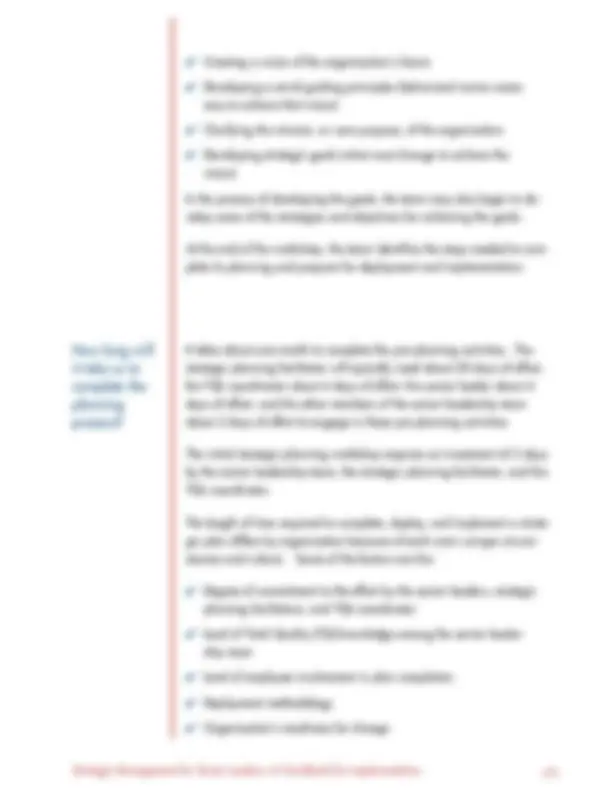

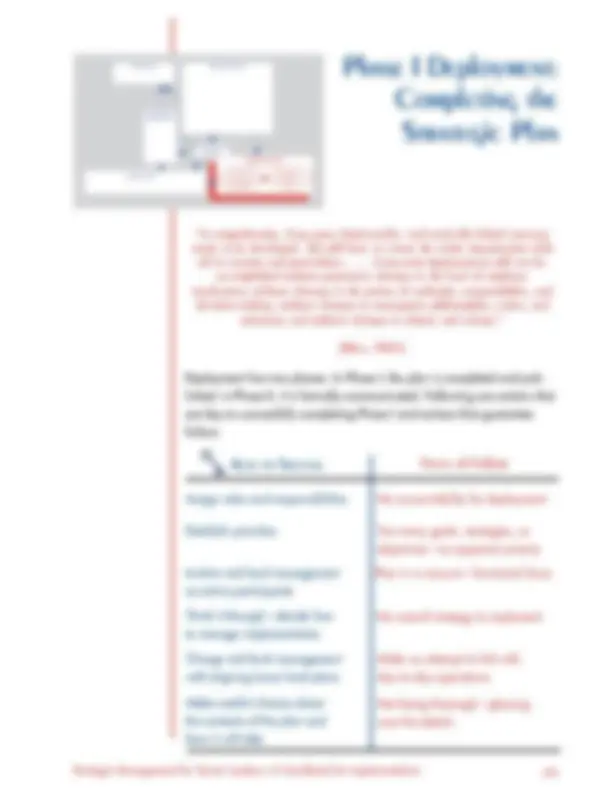
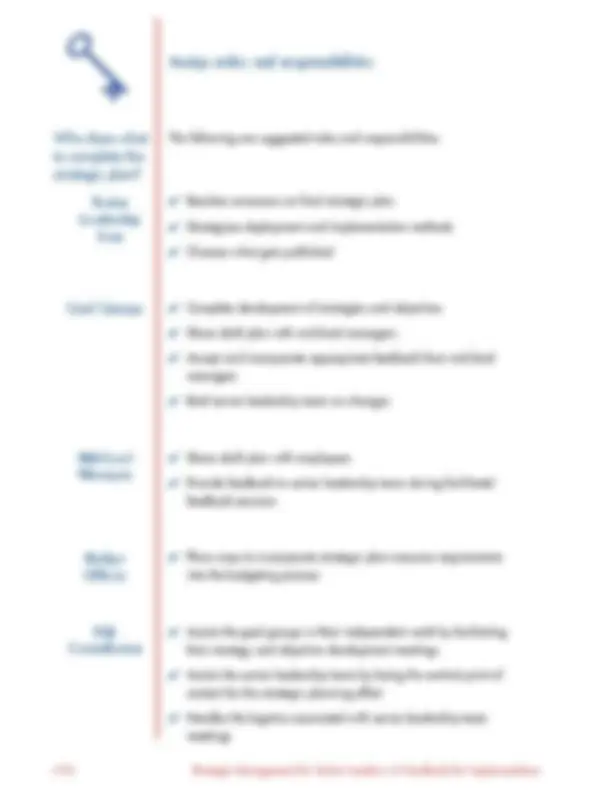

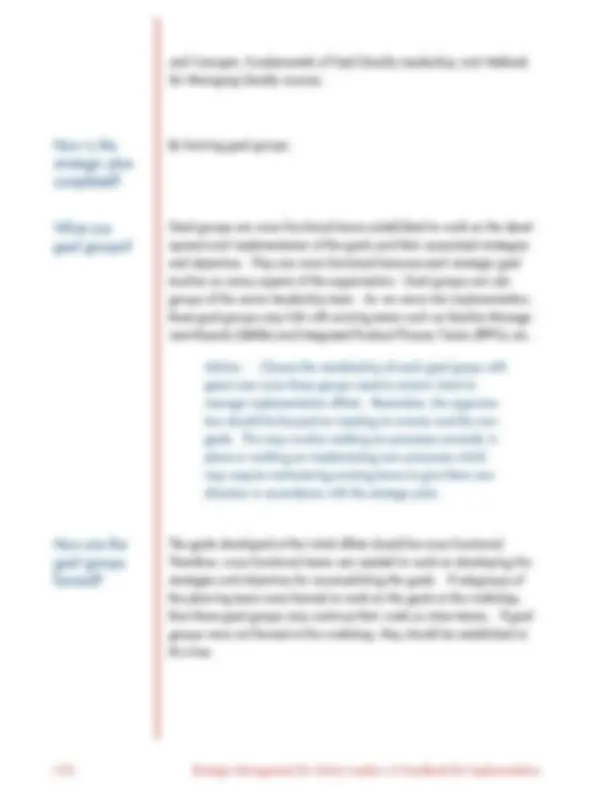
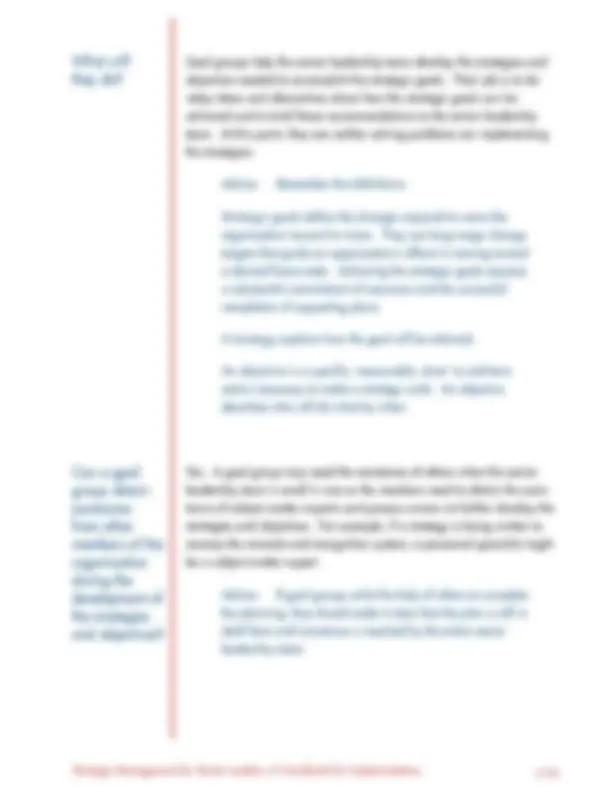



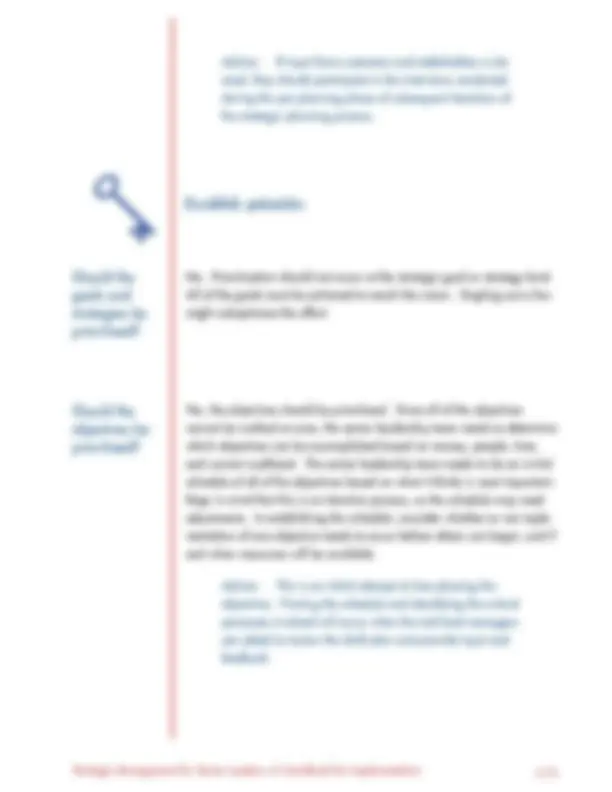

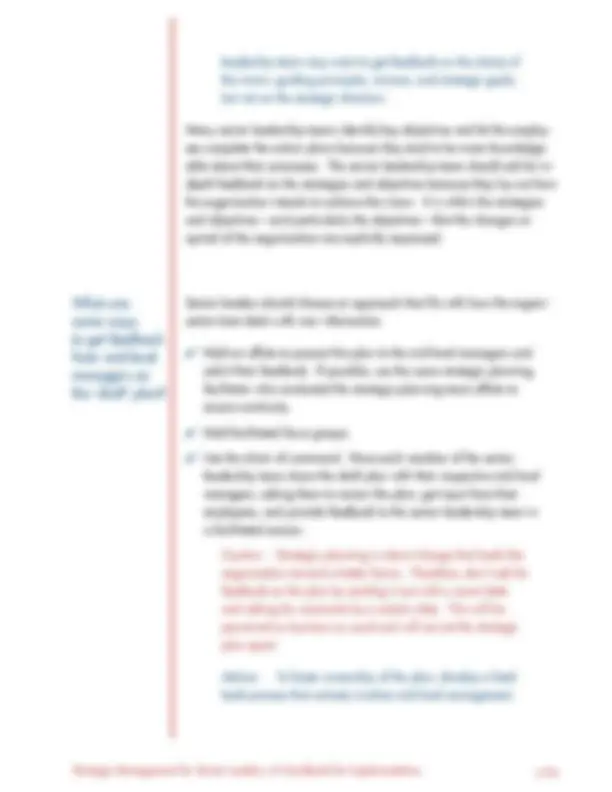
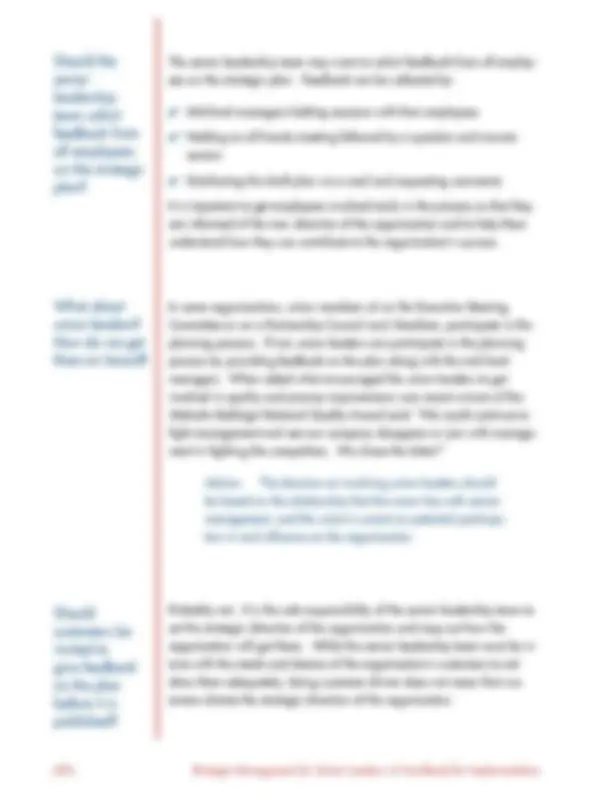

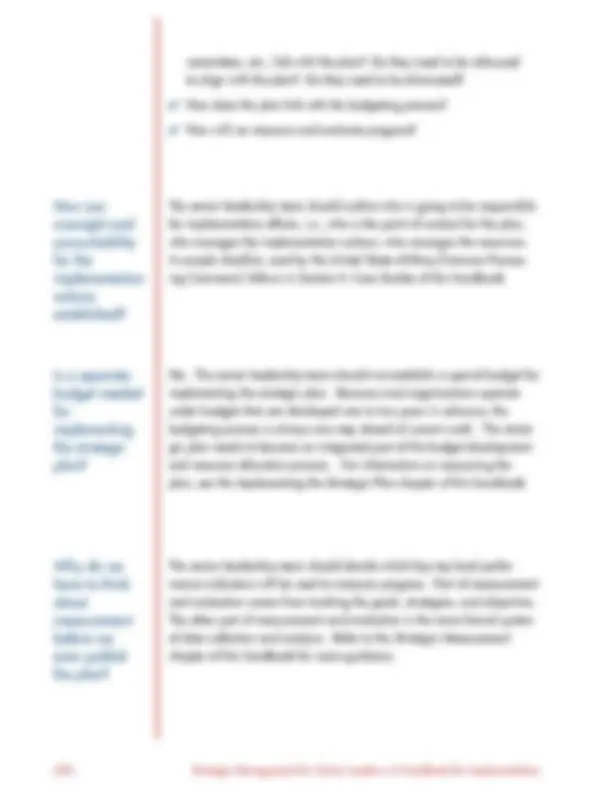
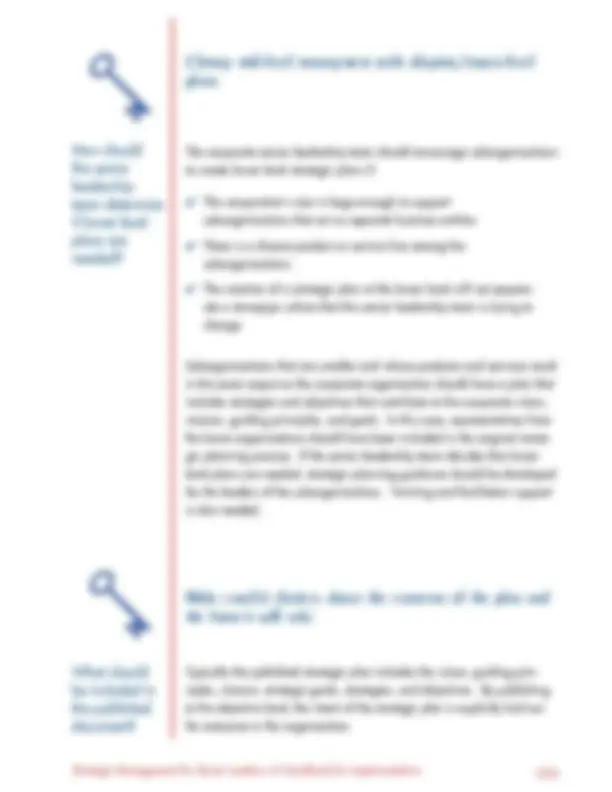



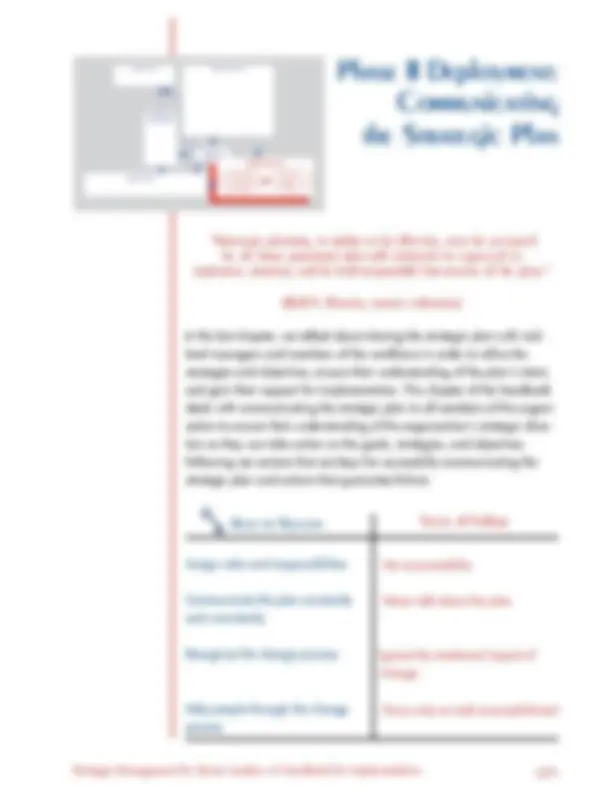
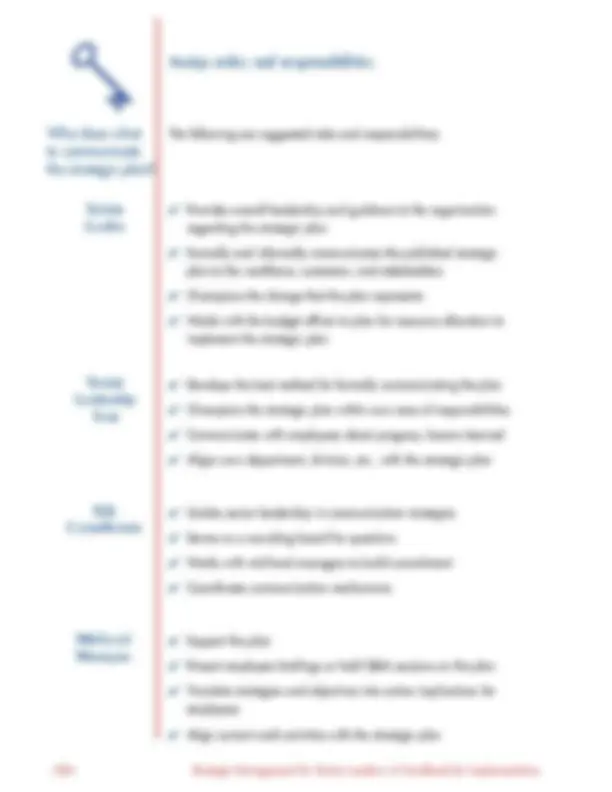
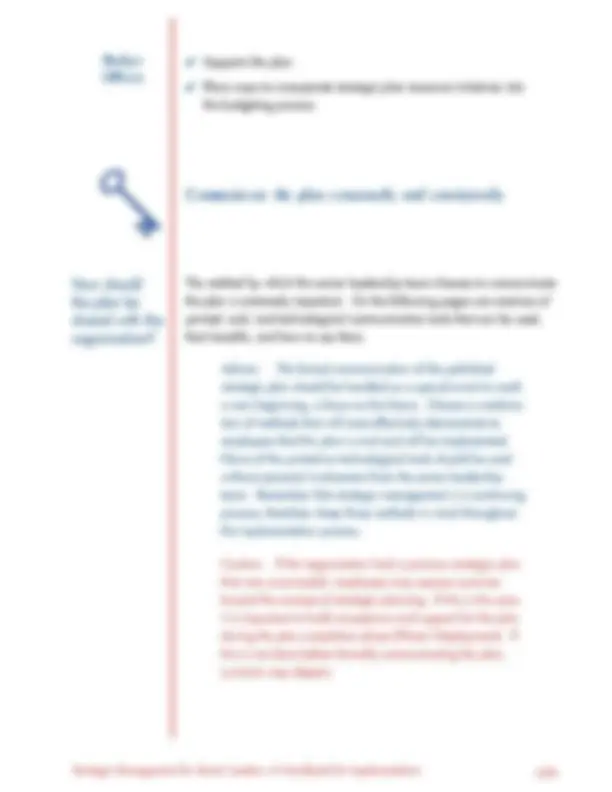


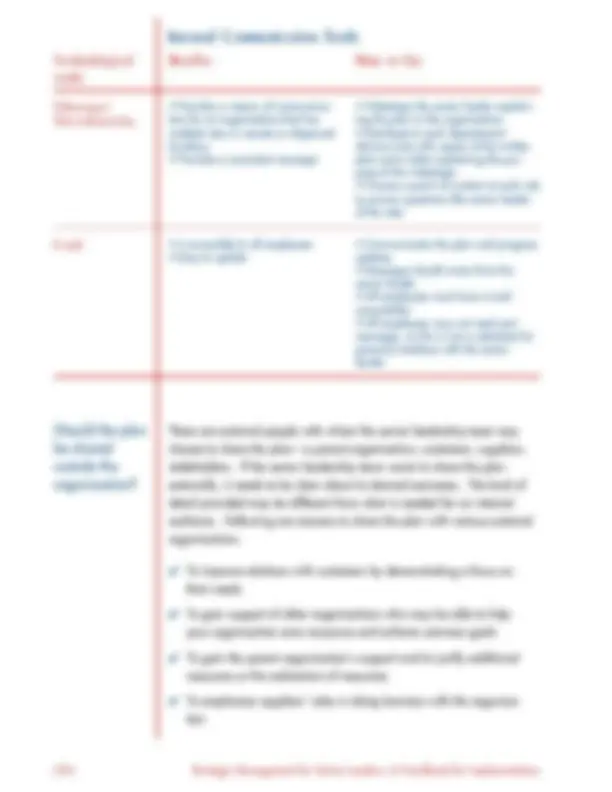
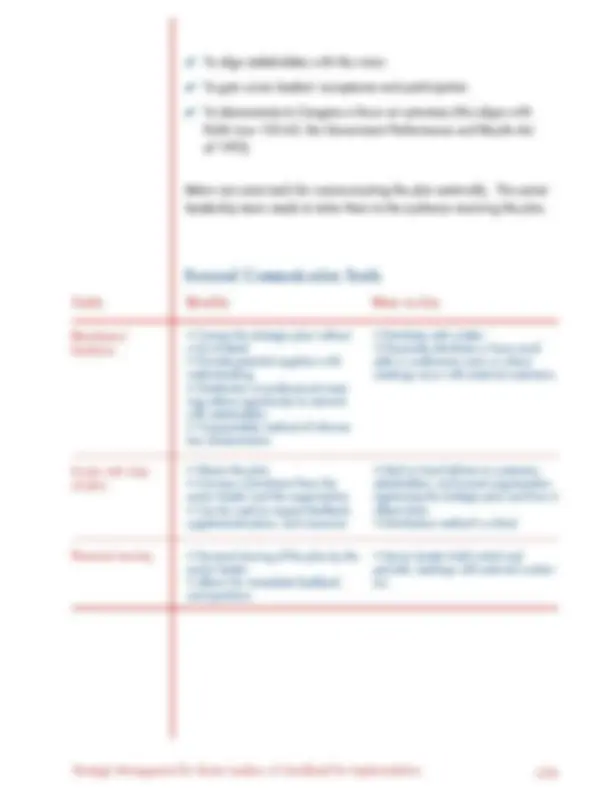
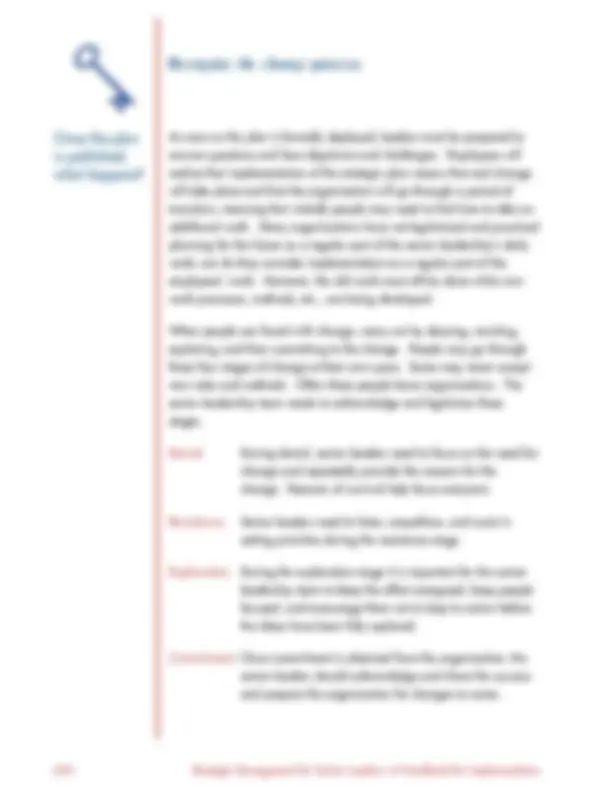
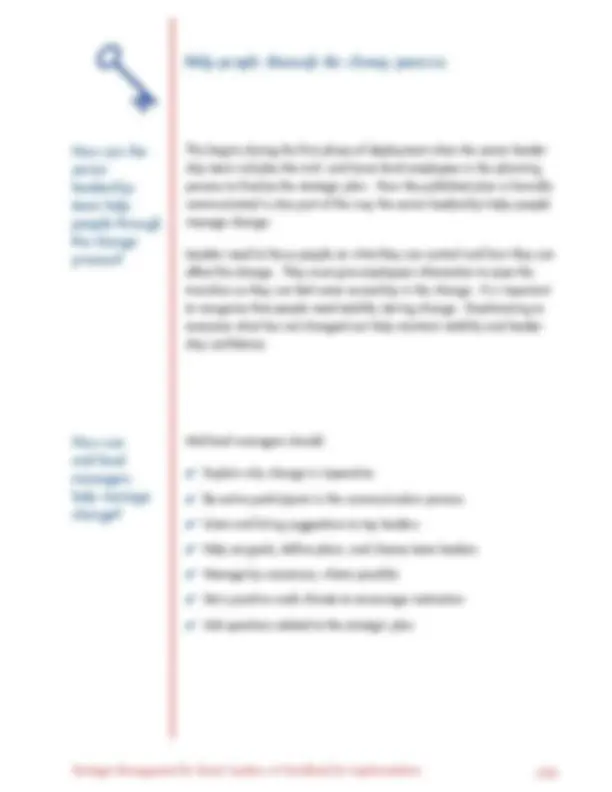
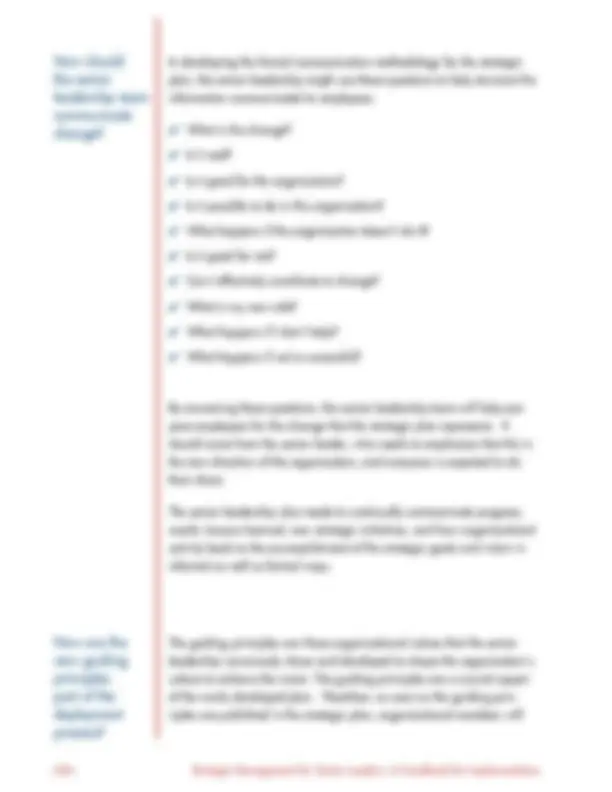
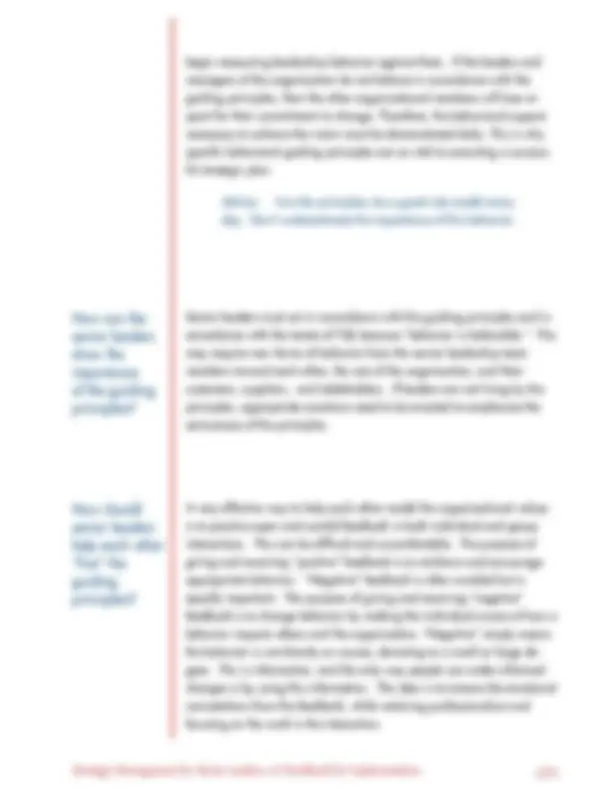

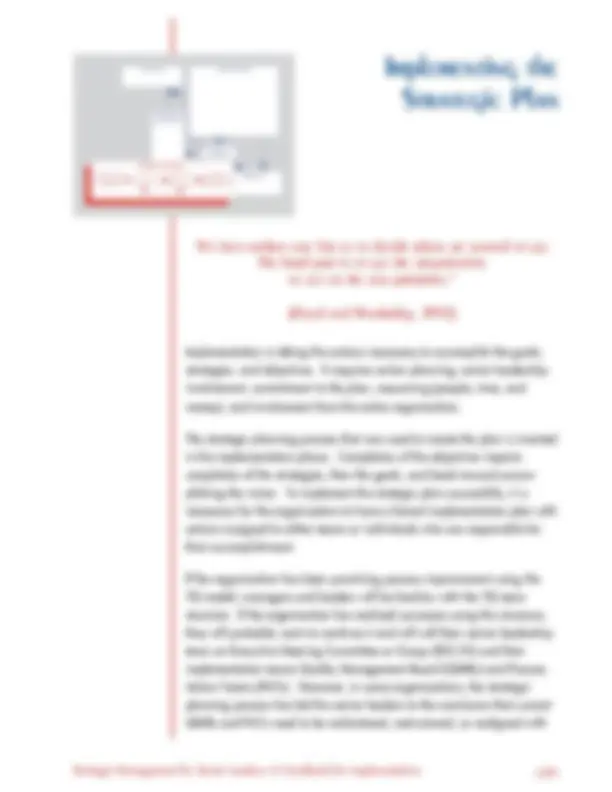
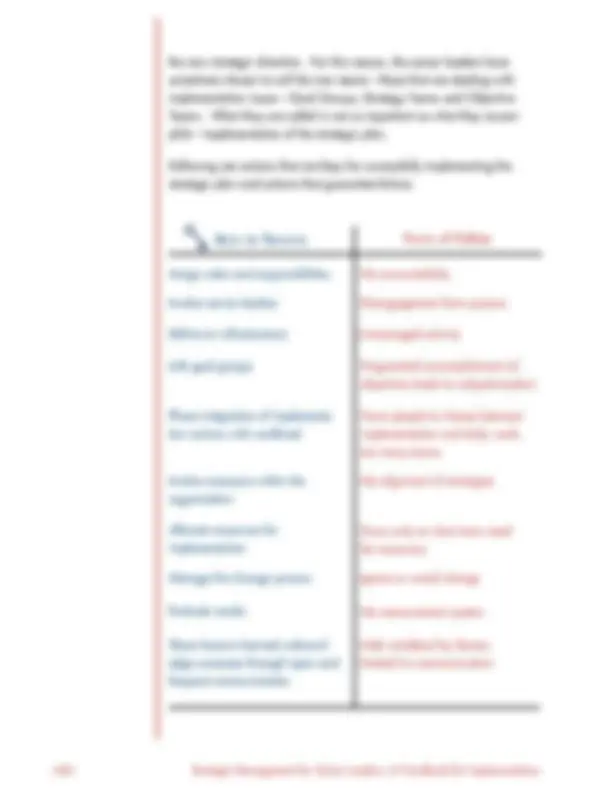
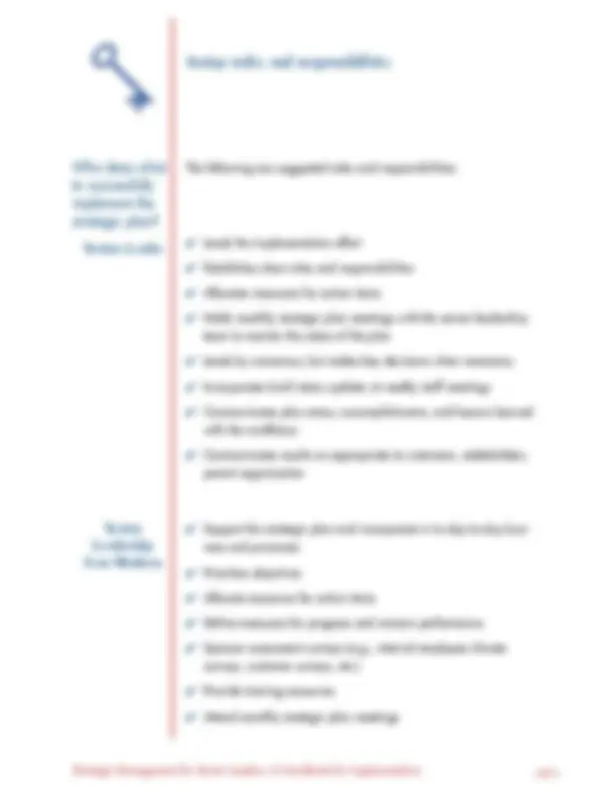
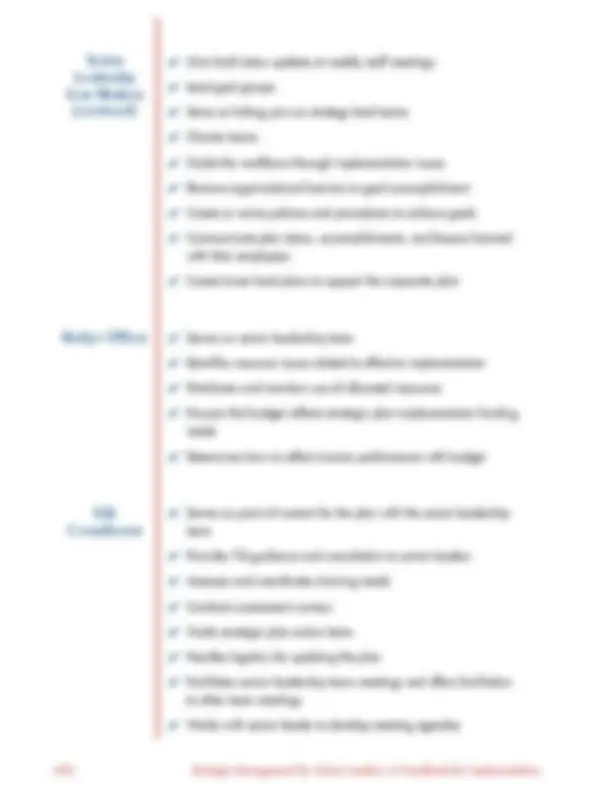
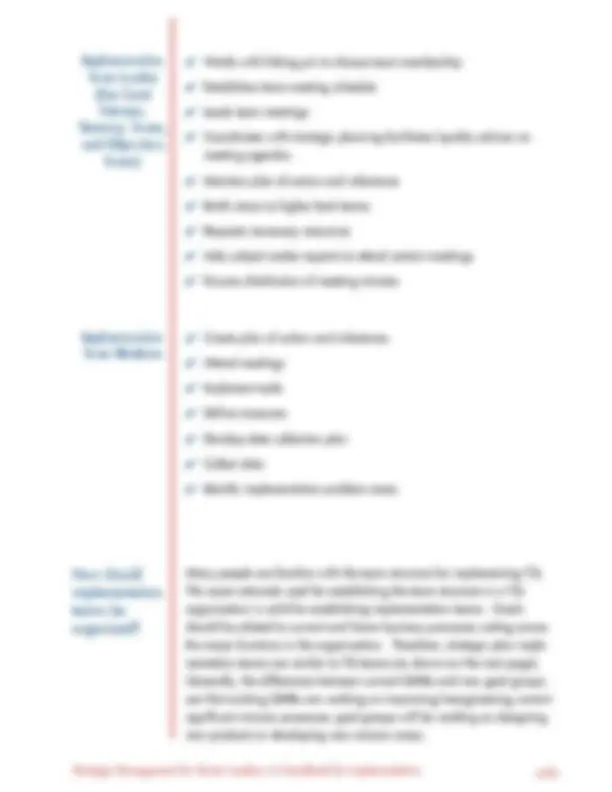
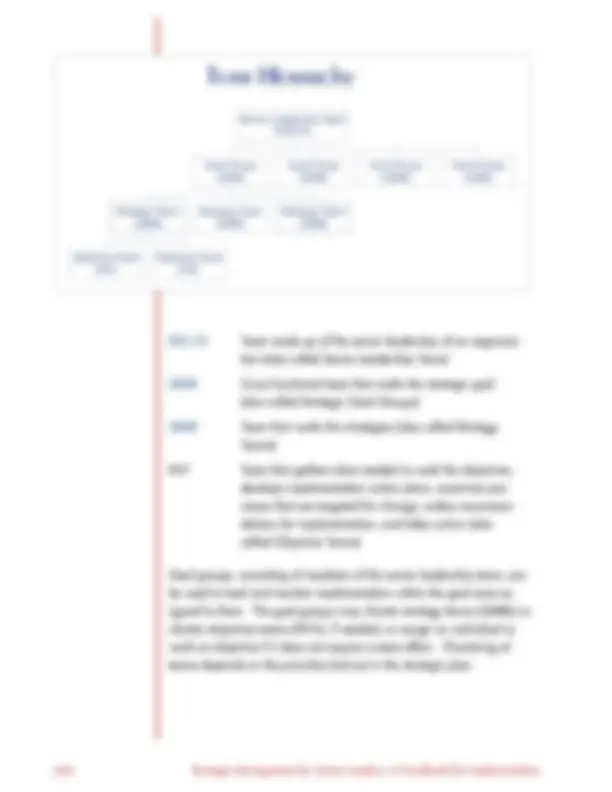
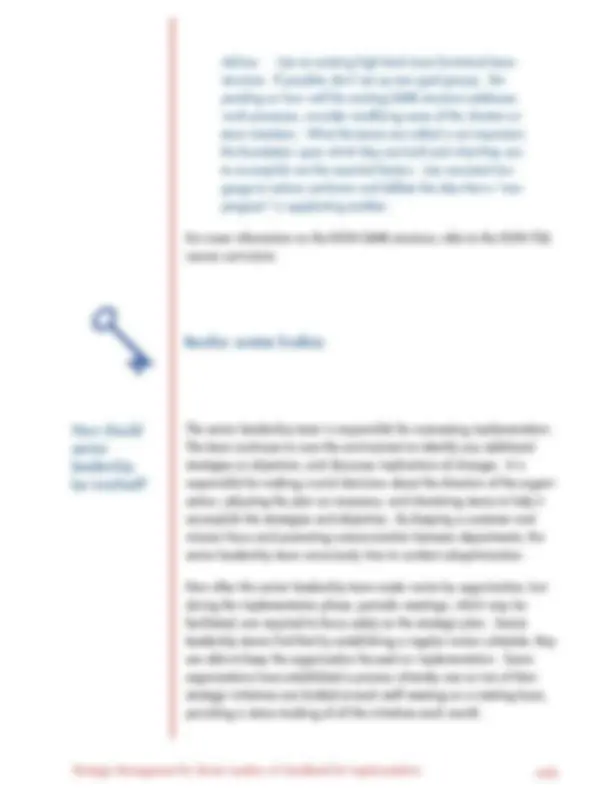
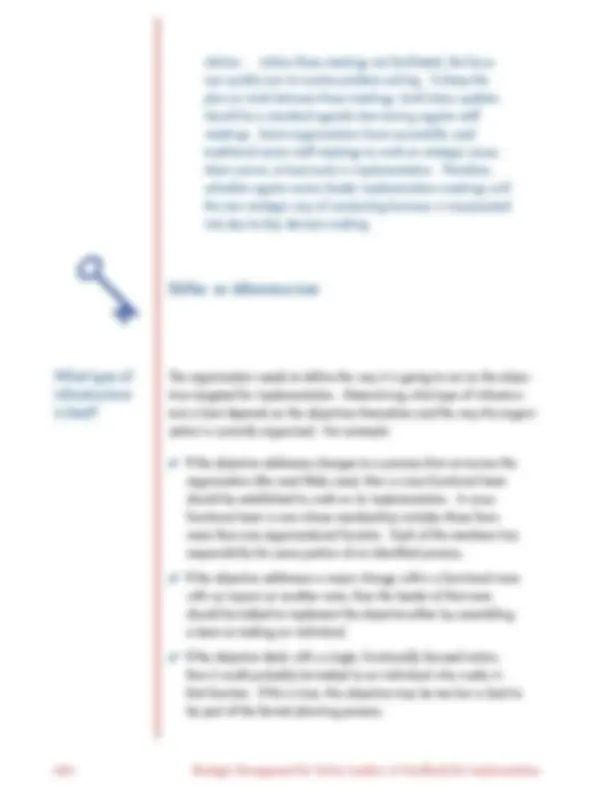
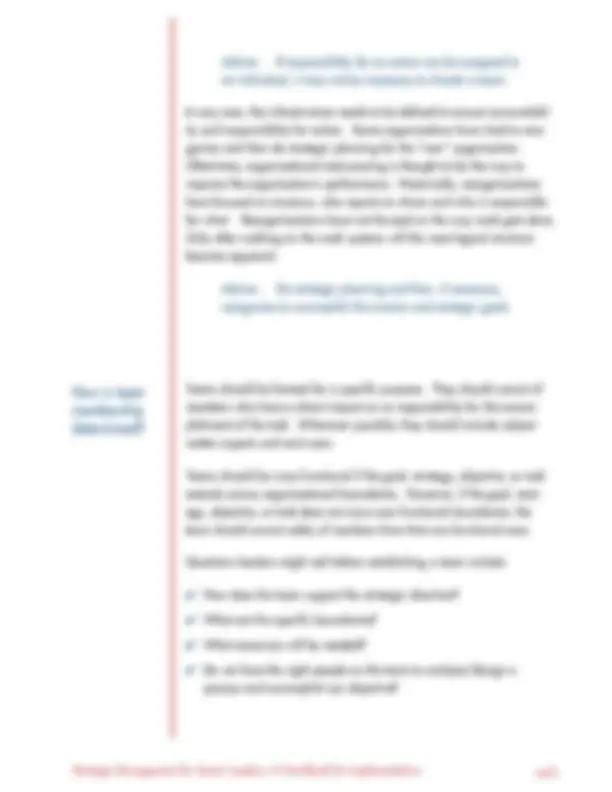
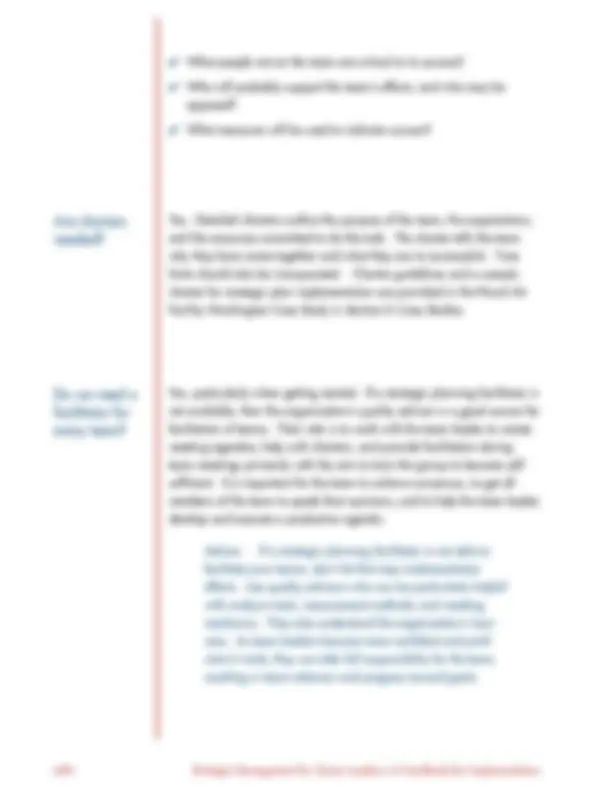

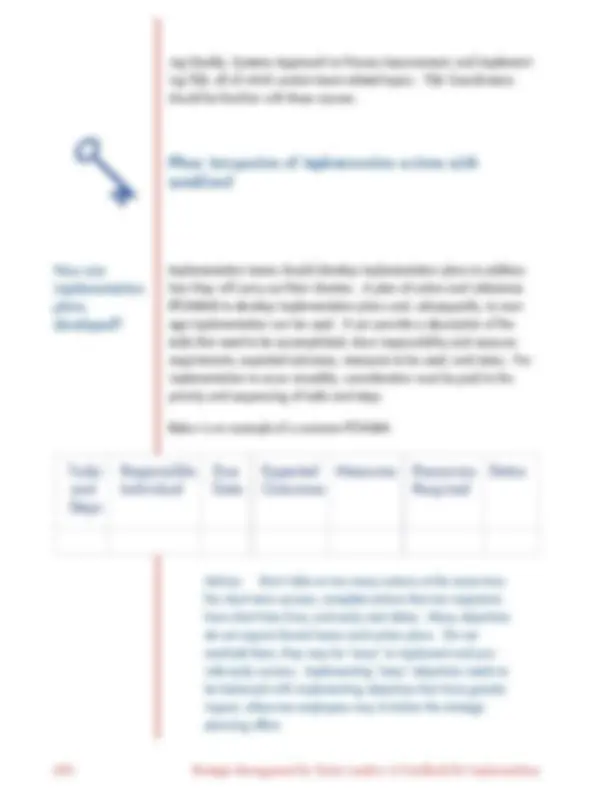
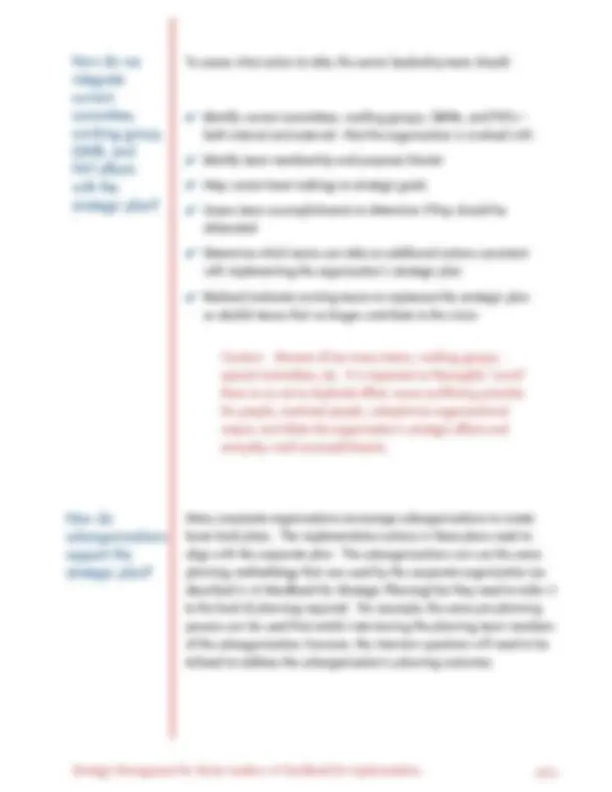

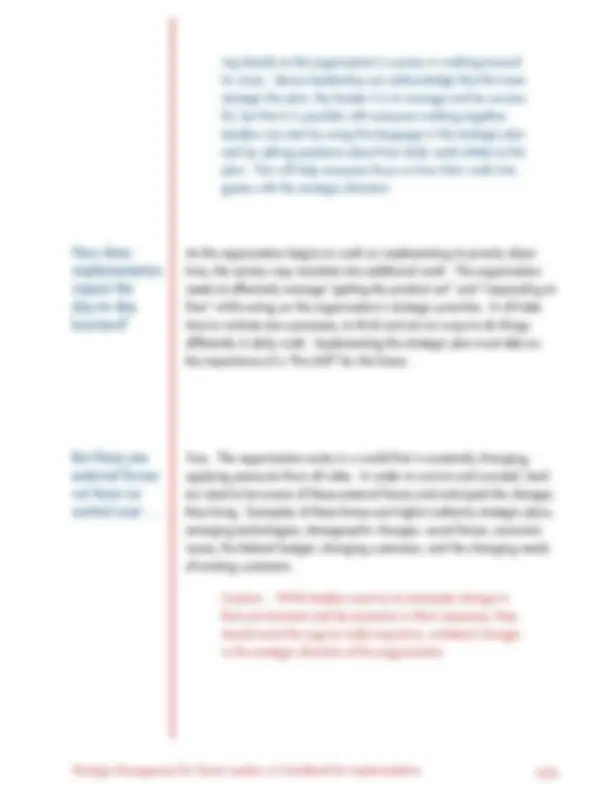
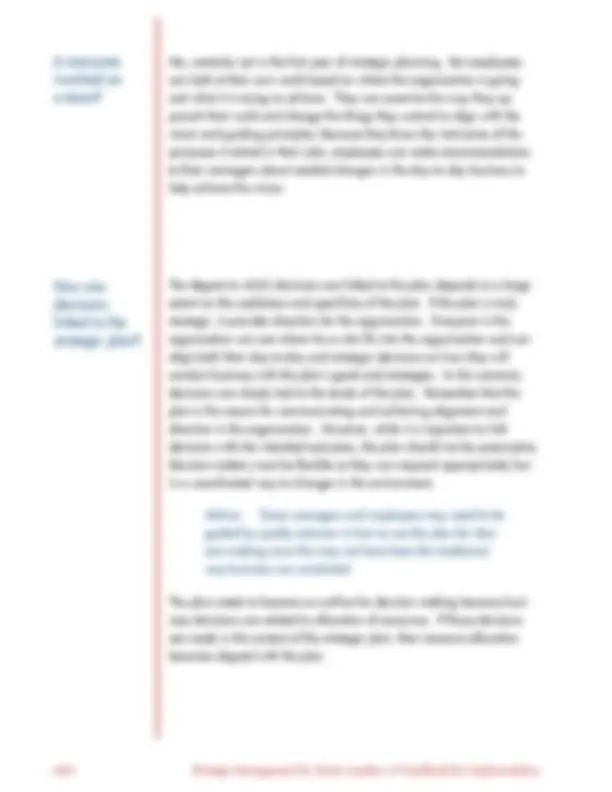
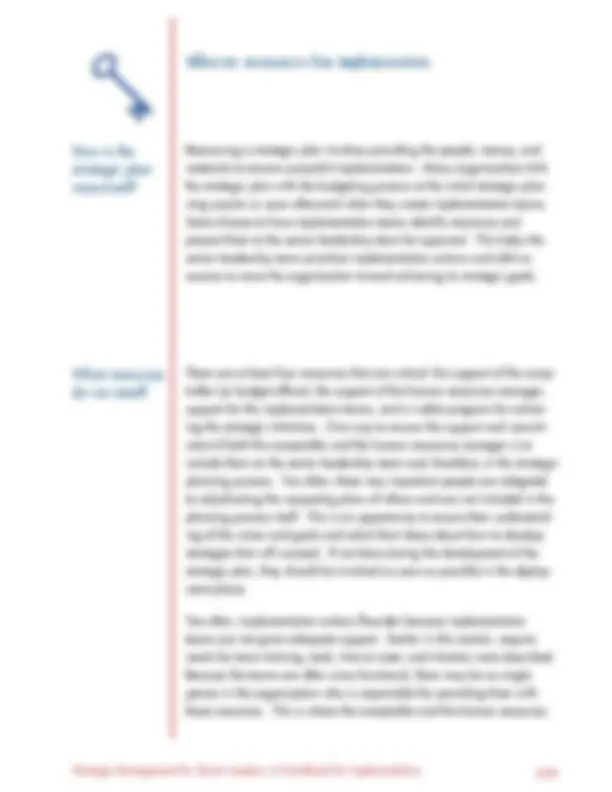
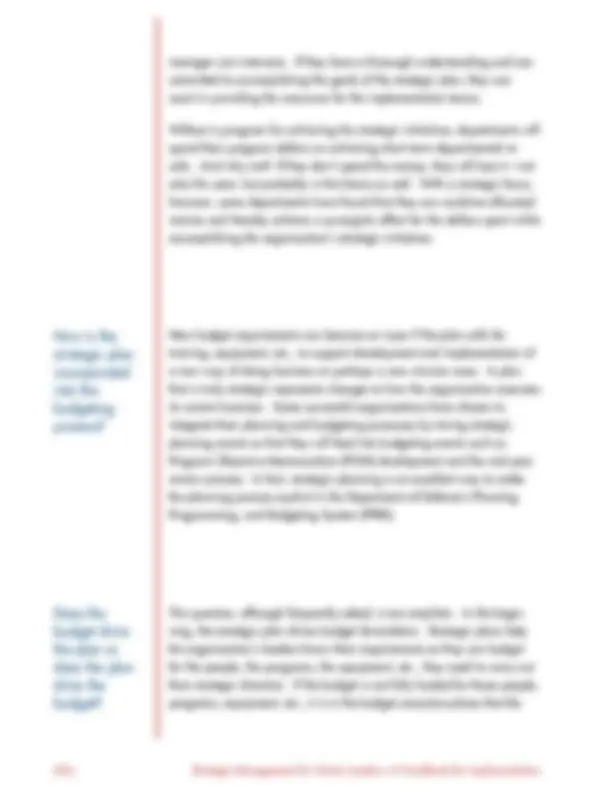


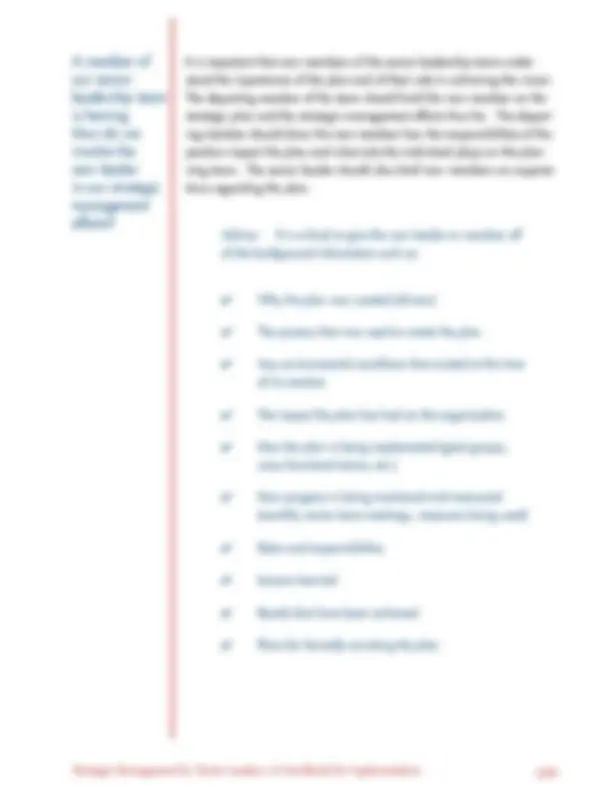



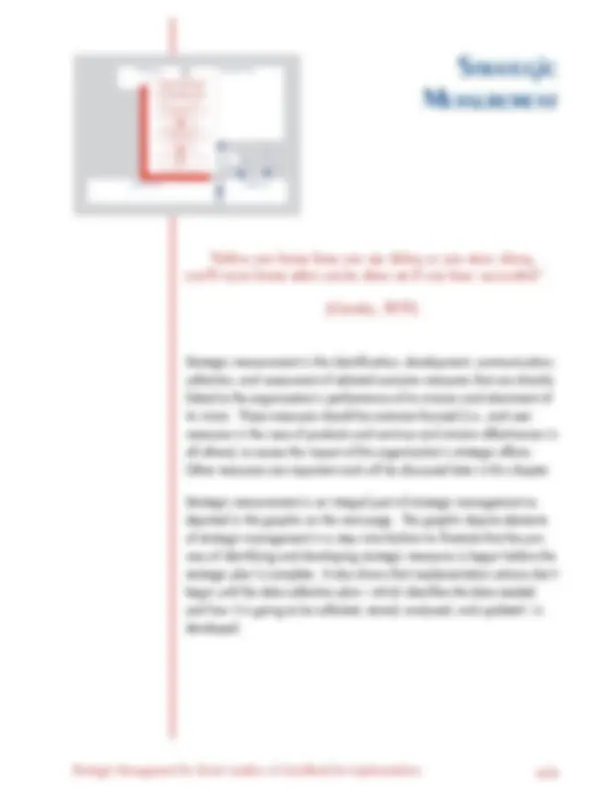
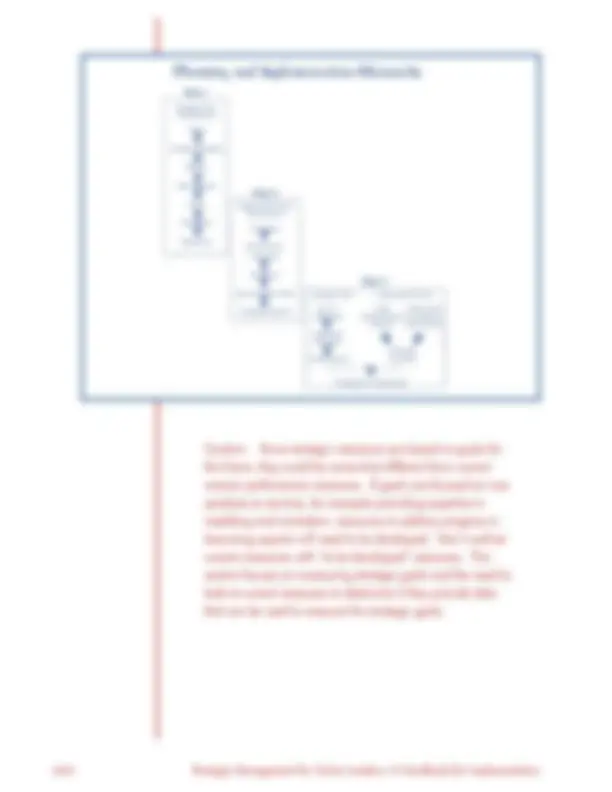
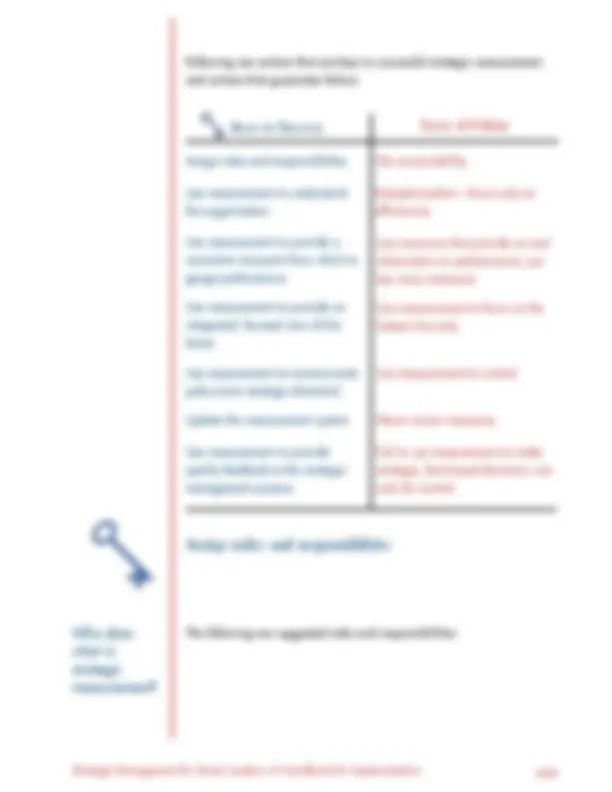
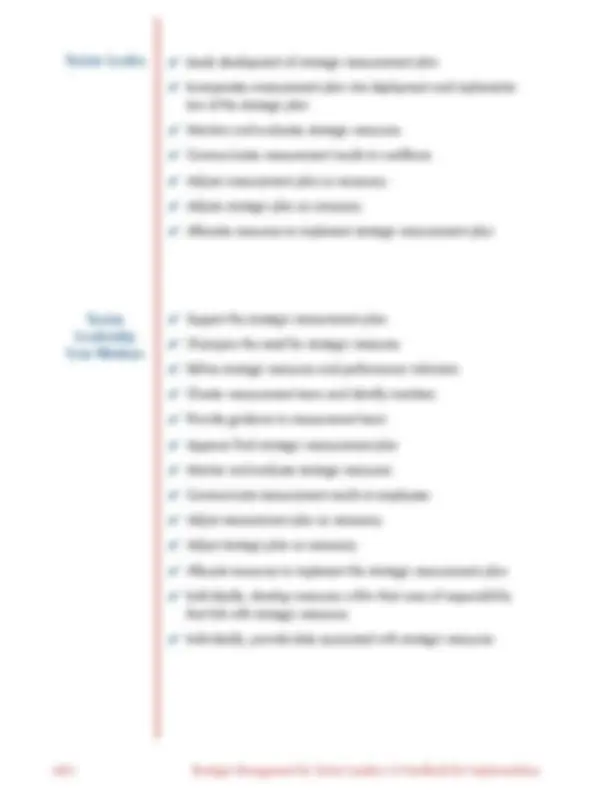
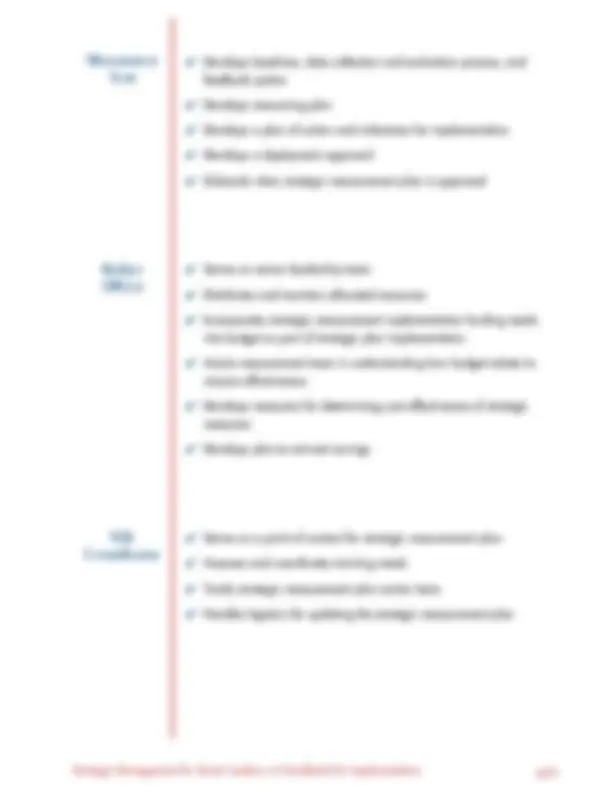
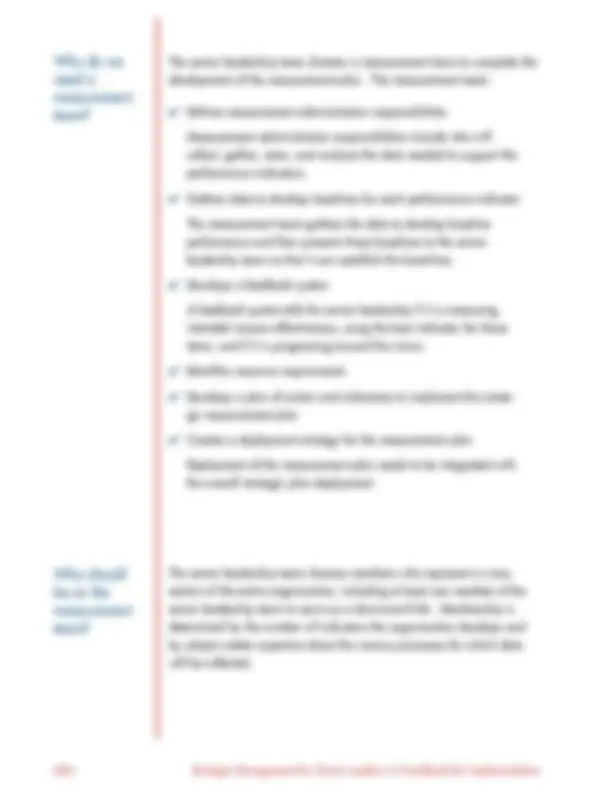
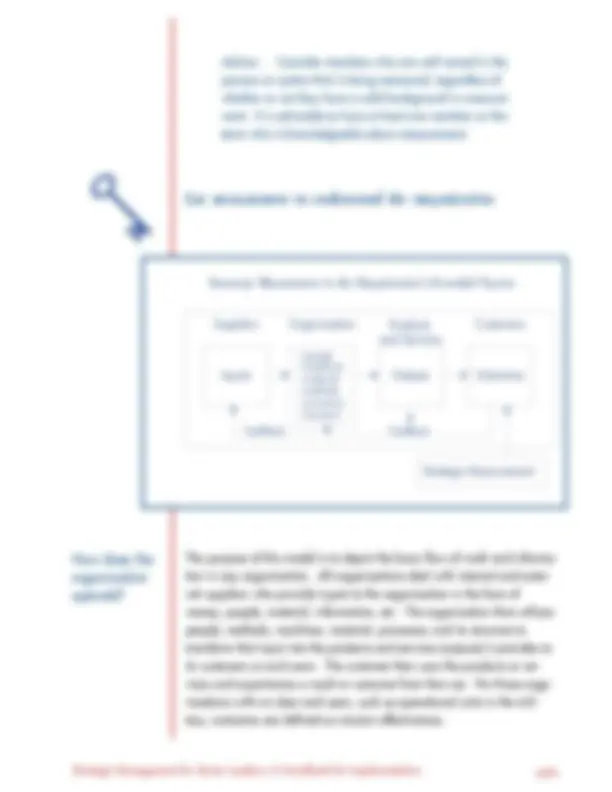
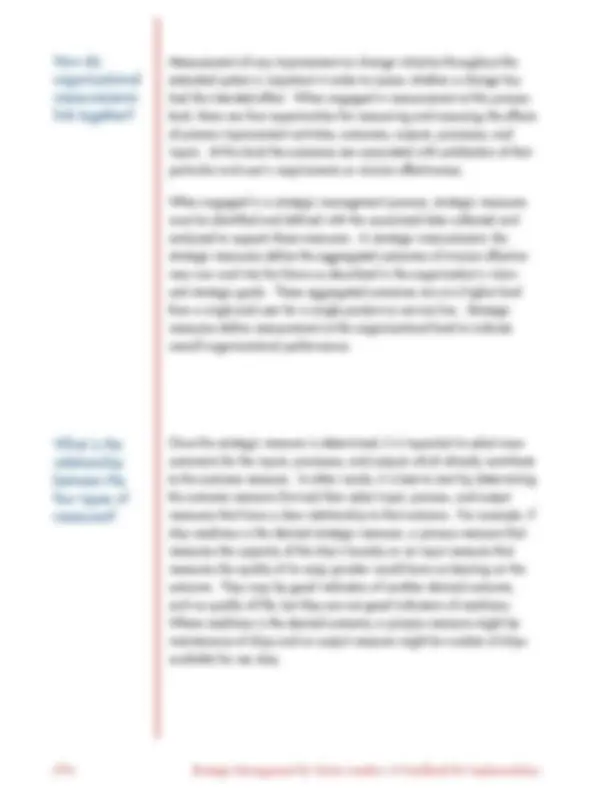
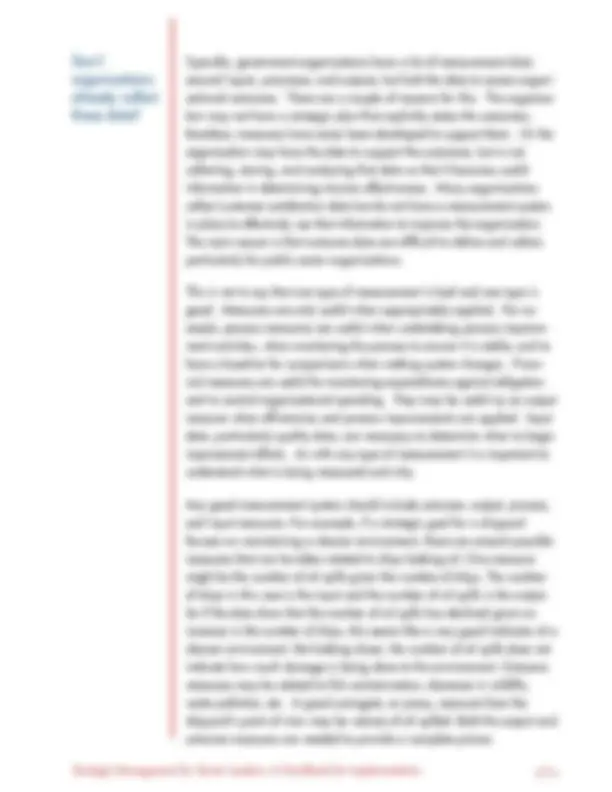
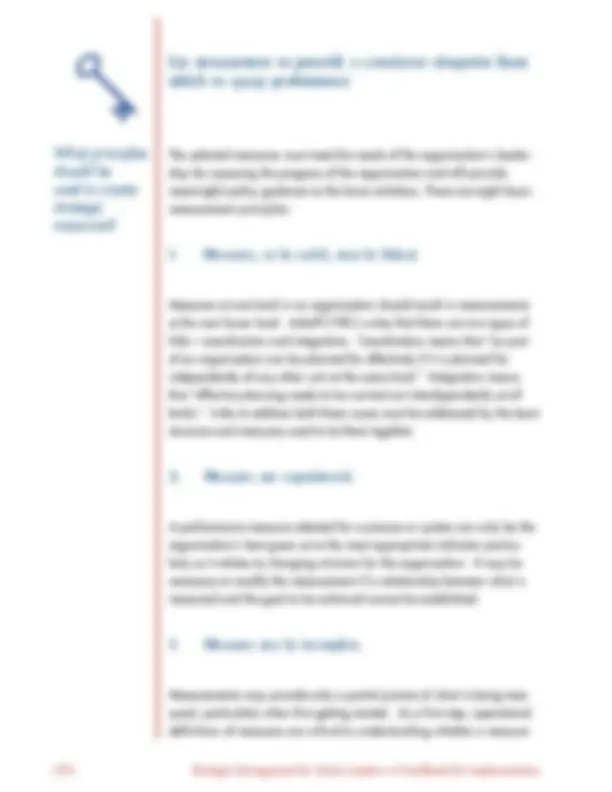
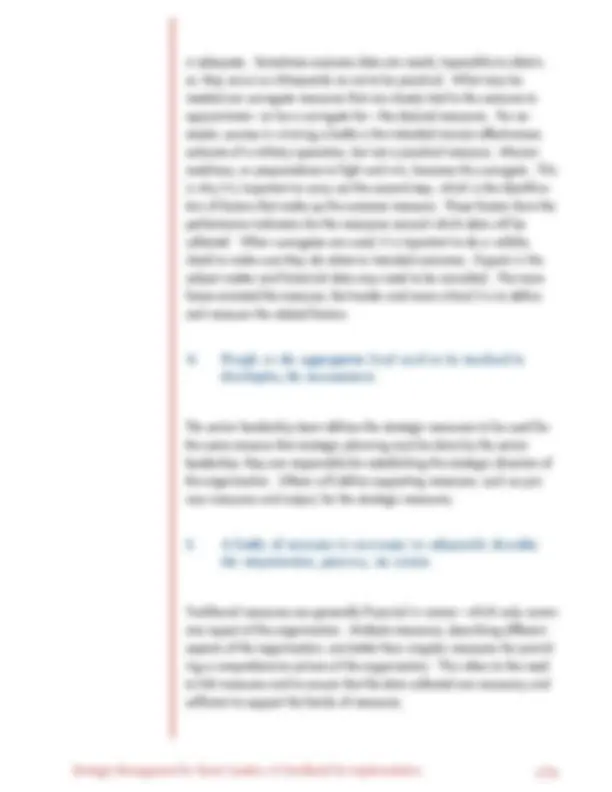
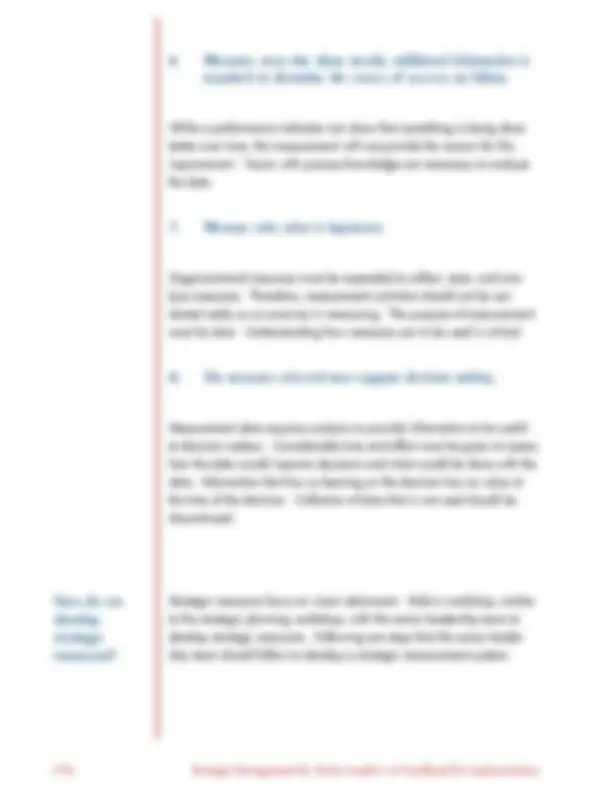
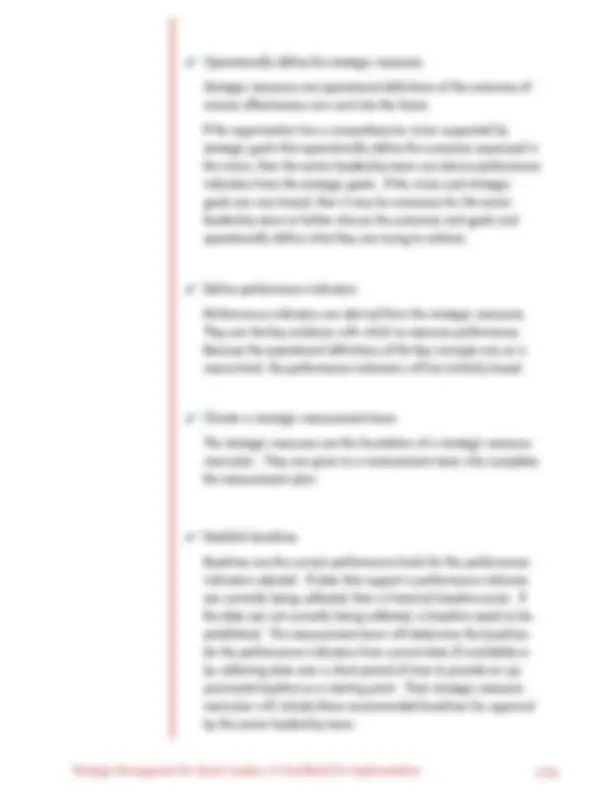
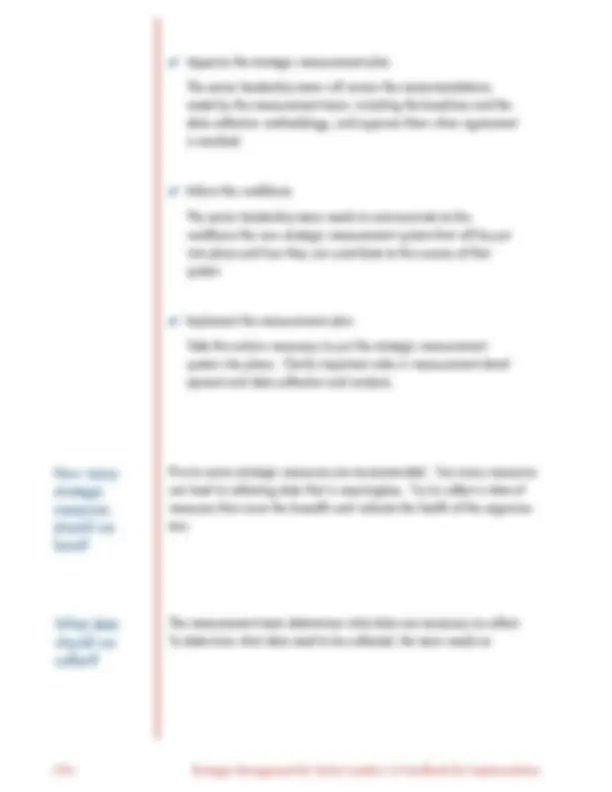

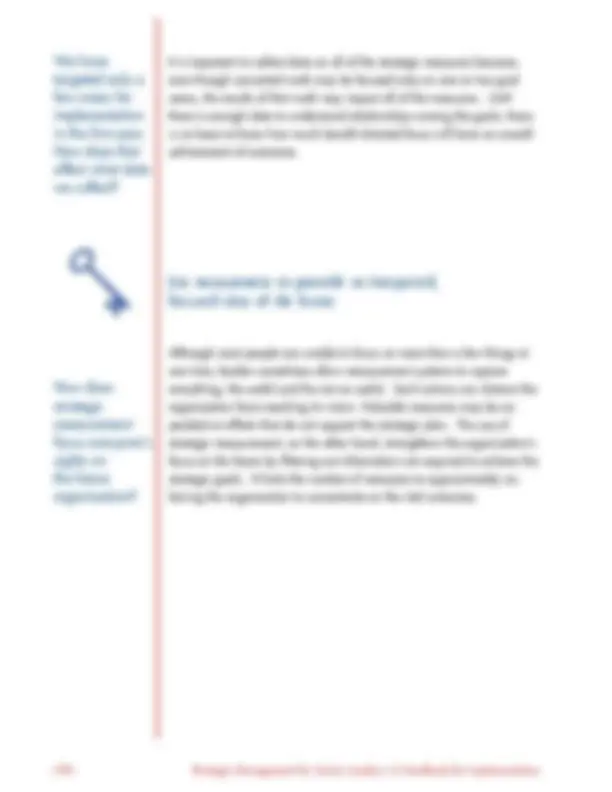
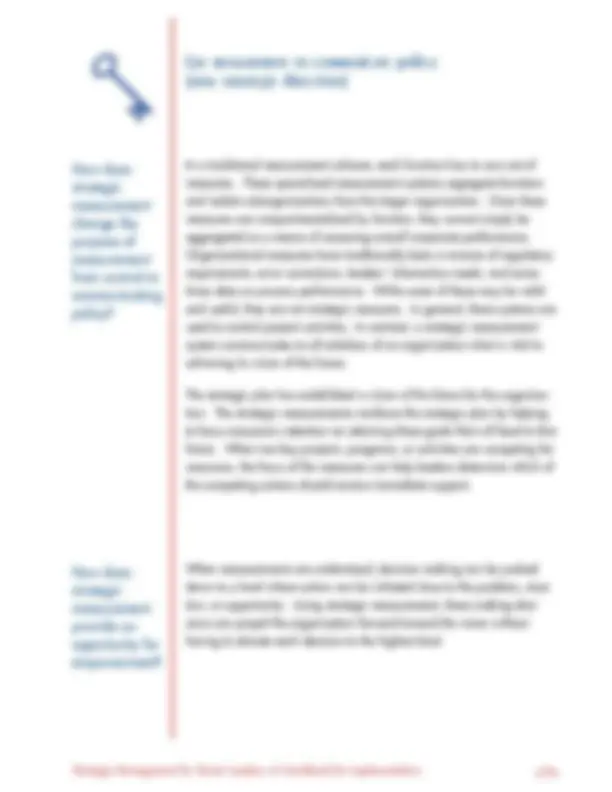

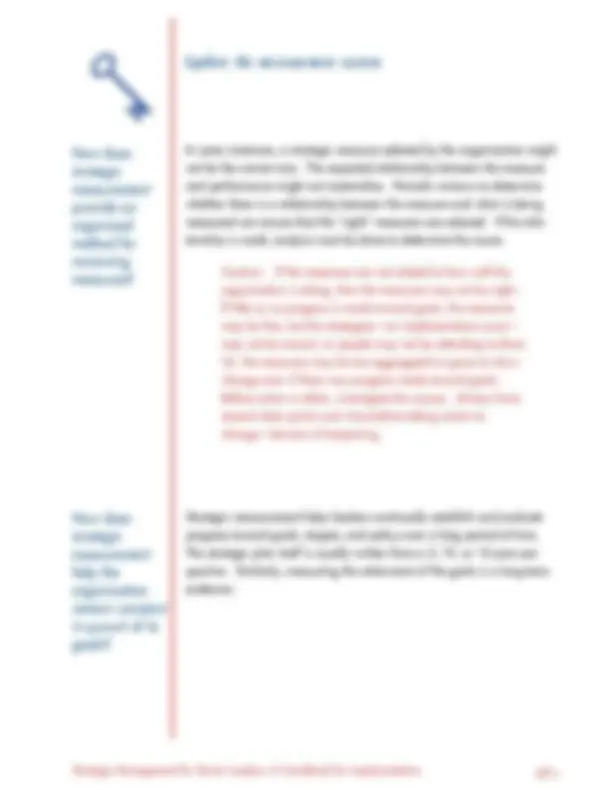

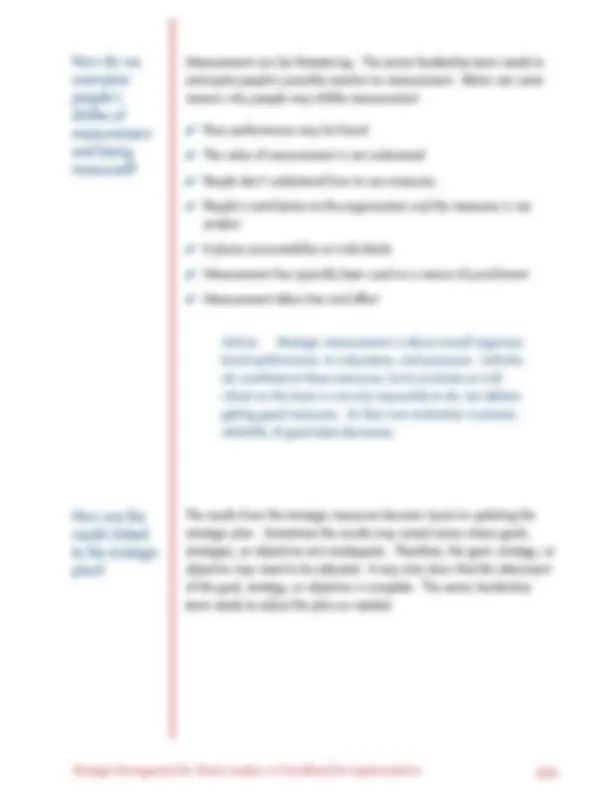

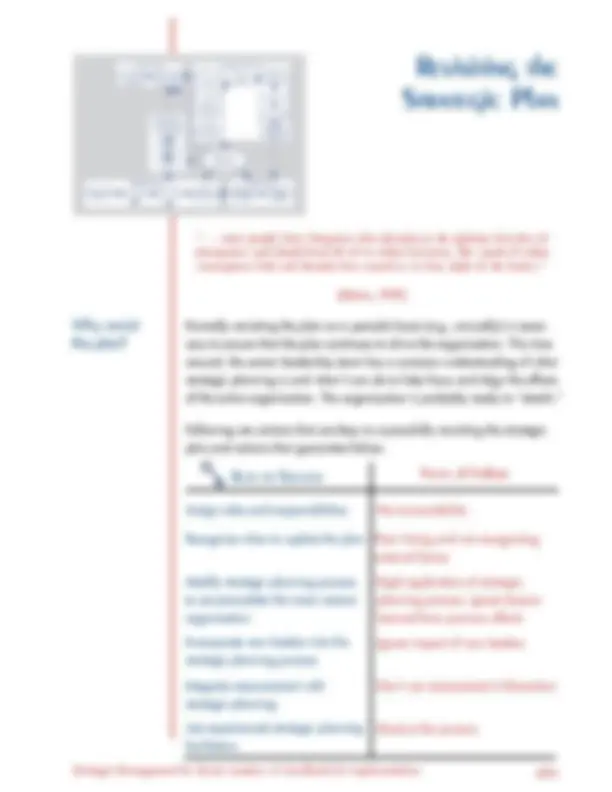
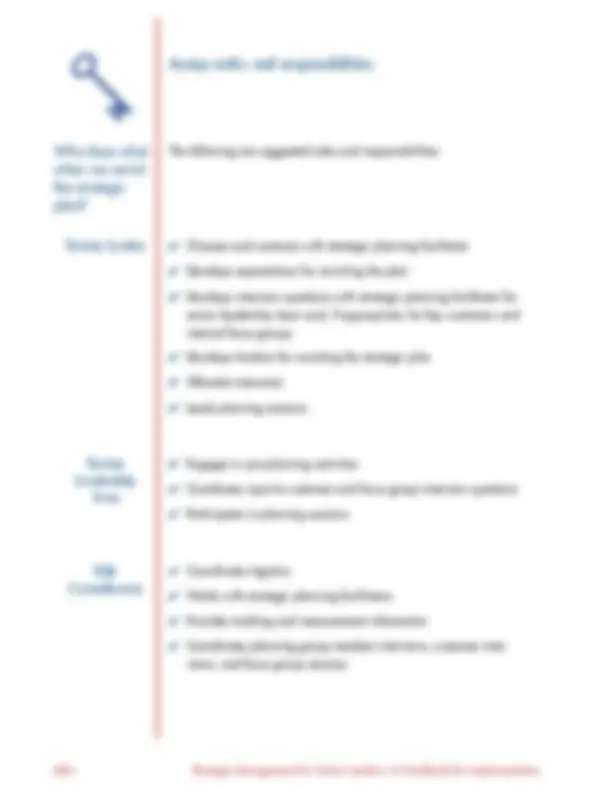


Study with the several resources on Docsity

Earn points by helping other students or get them with a premium plan


Prepare for your exams
Study with the several resources on Docsity

Earn points to download
Earn points by helping other students or get them with a premium plan
Community
Ask the community for help and clear up your study doubts
Discover the best universities in your country according to Docsity users
Free resources
Download our free guides on studying techniques, anxiety management strategies, and thesis advice from Docsity tutors
The importance of strategic planning in organizations, including assigning roles and responsibilities, using measurement for performance evaluation, and updating the measurement system. It also provides suggested roles and responsibilities for senior leaders, measurement team members, and goal group leaders in the strategic planning process.
What you will learn
Typology: Study notes
1 / 173

This page cannot be seen from the preview
Don't miss anything!





























































































The mission of the Total Quality Leadership (TQL) Office, Office of the Under Secretary of the Navy, is to assist the Department of the Navy (DON) leaders in their quality-focused improvement efforts. The TQL Office also provides technical advice to a number of organizations inside and outside government. The TQL Office has responsibilities in six key areas:
The TQL Office educates the DON about TQL policies and initiatives through the TQLeader and through articles, reports, and presentations at conferences and meetings. It has developed a computer-based quality information net- work to facilitate communication with DON organizations.
Systems are needed to assess and enhance TQL implementation in the DON. The TQL Office designs and develops feedback mechanisms in support of mission accomplishment. It also develops new approaches to improving organizational effectiveness.
TQL Office members provide technical advice to the Under Secretary of the Navy and other senior DON leaders on the application of TQL principles and methods within the DON and on strategic planning. Advice may also take the form of recommendations on implementing new laws, such as the Government Performance and Results Act, as well as on related initiatives.
The TQL Office is responsible for ensuring the technical accuracy of the DON TQL curriculum. Having overseen the design and development of the courses, the staff now advises on the integration of TQL material into training pipelines. The TQL Office continues to publish handbooks and other publications on all aspects of organizational change and to design new courses.
The TQL Office has much to share with other organizations, both government and private, and much to learn from them. Staff members participate in TQL-related networks and professional organizations.
Technology can provide critical support to DON quality improvement efforts. The job of the TQL Office is to assess new technologies related to organiza- tional change and process improvement and translate them into applications for the DON.
About the TQL Office
ï iiï Strategic Management for Senior Leaders: A Handbook for Implementation
the future, let alone put plans into action to reach that future. Yet, strate- gic management requires dedication and commitment on the part of the senior leaders to create the vision of the future. Then they must create the mechanisms and commit the resources to achieve that future. This hand- book will help them go beyond planning and use their strategic plans to change the way they do business.
The principal research for Strategic Management for Senior Leaders: A Handbook for Implementation was done by a Logicon Syscon Corpora- tion team (under subcontract to K.W. Tunnell Co., Inc., contract number GS-22F-0096B). I especially want to recognize the efforts of Ms. Kathy Burks, whose strategic planning expertise contributed to the success of this project. We hope readers find this handbook useful as they continue to lead their organizations into the future.
Strategic Management for Senior Leaders: A Handbook for Implementation ïiii ï
Foreword ............................................................................... i
Acknowledgments ................................................................. vii
How to Use this Handbook..................................................... xi
Section I: Guidance................................................................ 1
An Introduction to Strategic Management ............................ 3
Phase I Deployment: Completing the Strategic Plan ............... 9 Keys to Success .................................................................... 9
Assign roles and responsibilities .......................................... Establish priorities .............................................................. Involve mid-level management as active participants............. Think it throughódecide how to manage implementation...... 21 Charge mid-level management with aligning lower-level plans ................................................................ Make careful choices about the contents of the plan and the form it will take ......................................................
Phase II Deployment: Communicating the Strategic Plan ..... 27 Keys to Success .................................................................. 27
Assign roles and responsibilities .......................................... Communicate the plan constantly and consistently ................ 29 Recognize the change process............................................. Help people through the change process ..............................
Contents
ï viï Strategic Management for Senior Leaders: A Handbook for Implementation
ï viiiï Strategic Management for Senior Leaders: A Handbook for Implementation
Marine Corps Multi-Commodity Maintenance Center, Barstow, CA Col. Larkin Conaster, Commanding Officer Joann Bond, Total Quality Coordinator Mike Burke, Total Quality Facilitator Marine Corps University, Quantico, VA COL Hoeft, Commanding Officer LCOL Bud Meador, Total Quality Coordinator Naval Air Facility, Andrews Air Force Base, Washington, DC CAPT Randall Suratt, Commanding Officer ATC Robert Chandler, Total Quality Coordinator Naval Air Station, Barbers Point, HI CAPT Edward Waller, Commanding Officer LCDR Lou Mosier, Total Quality Coordinator Naval Air Station, Miramar, CA CAPT R. L. Casey, Commanding Officer Martin (Gene) Hepler, Total Quality Coordinator Naval Dental Center, San Diego, CA CDR Leary, Total Quality Coordinator Naval Facilities Engineering Service Center, Port Hueneme, CA CAPT John Collins, Commanding Officer Steve Smuck, Total Quality Coordinator Naval Reserve Force, New Orleans, LA Jan Bowen, Total Quality Coordinator Naval Security Group, Chesapeake, VA CAPT Sharon Peyronel, Commanding Officer CTMCS (AW) Patricia Nolan, Total Quality Coordinator Naval Station, Mayport, FL CAPT Scott Cantfil, Commanding Officer Diane Shepherd, Total Quality Coordinator Naval Undersea Warfare Center, Keyport, WA CAPT Dennis Gibbs, Commanding Officer Dallas Likens, Executive Director Mike Kelf, Strategic Plan Leader John Ebert, Total Quality Coordinator
Strategic Management for Senior Leaders: A Handbook for Implementation ïix ï
Program Executive Office, Surface Combatants/AEGIS Program, Washington, DC John Kuesters, Deputy AEGIS Program Manager CAPT Grey Glover, Chief of Staff Shore Intermediate Maintenance Activity, Portsmouth, VA CDR Paul Clausen, Jr., Commanding Officer MRCS (SW) Elvis Jefferson, Total Quality Coordinator Shore Intermediate Maintenance Activity, San Diego, CA CAPT Gary Bier, Commanding Officer Joyce Ward, Total Quality Coordinator
Deputy Secretary of Defense, Personnel Support, Family, and Education, Washington, DC Carolyn Becraft, Deputy Under Secretary of Defense for Personnel Support, Families, and Education Military Entrance Processing Command, North Chicago, IL COL Wanda Wood, Commanding Officer LTC Dave Bartlett, Jr., Total Quality Coordinator
Center for Veterinary Medicine, Rockville, MD Stephen Sundlof, D.M.V., Ph.D., Director Dave Lynch, Total Quality Coordinator Department of Agriculture, Organizational Development, Riverdale, MD Dan Stone, Co-Director of Organizational and Professional Development Department of Education, Washington, DC Alan Ginsburg, Director of Planning and Evaluation Service Department of Energy, Office of Nuclear Energy, Science, and Technology, Germantown, MD Howard Rohm, Deputy Director, Planning State of Utah, Salt Lake City, UT John Cannon, Research Analyst, Office of Legislative Research and General Counsel Lee King, Director, State and Local Planning, Governorís Office of Planning and Budget
Strategic Management for Senior Leaders: A Handbook for Implementation ïxi ï
How to use this Handbook
ìThere is no great tradition or heritage for strategic thinking in many organizations; the skill to set and implement strategy is sometimes missing; and there are barriers to strategy.. .. All this makes strategic thinking and action a tough challenge.. .. The first step requires finding the motivation to begin.î
(Tregoe, Zimmerman, Smith, and Tobia, 1989)
Strategic management is not a clean, step by step process. It is not linear, but a ìmessy,î iterative process that requires hard work and dedication from most people in the organization to move it toward the future. It represents a new focus for the organization; a focus on a compelling vision of the future. This handbook is designed to help organizational leaders take steps to begin a strategic management process.
This handbook has been organized in three main sections. Section I provides guidance on the processes which comprise strategic manage- ment. These are: pre-planning, strategic planning, deployment, imple- mentation, and measurement and evaluation. A model is presented in An Introduction to Strategic Management and this model is repeated in each chapter, highlighting the process being addressed.
The Keys to Success and Facts of Failure provide an overview of each chapter. These Keys are determinants of successful strategic management and while they apply to the entire system of strategic management, they are best addressed in the chapter in which they are presented. Questions following the Keys are those frequently asked of strategic planners. Their answers are intended to help the reader understand who, what, when, why, and how to be successful. The first Key in every chapter is ìAssign roles and responsibilities,î because roles and responsibilities change as the organization moves through the various phases of strategic manage- ment.
ï xiiï Strategic Management for Senior Leaders: A Handbook for Implementation
Facts of Failure are not addressed directly in the handbook because they are simply the Keys to Success stated conversely. Failure to adequately consider and act upon the Keys generally in the process in which they are presented can diminish successful implementation of the strategic direction.
Both the Keys to Success and the Facts of Failure have been gleaned from the management research literature combined with and validated by the experiences of the participating organizations and of the author. Words of Advice and Caution are interspersed to highlight main points. The decisions made at these junctures can lead to success or failure.
Section II presents case studies from four of the organizations interviewed as part of the research effort for development of this handbook. The case studies follow the key processes of strategic management. Each one contains a summation of the organizationís vision, mission, and guiding principles, and an overview of its strategic management process. The case studies illustrate four different approaches to strategic management and how these organizations handled the various phases of their strate- gic management effort.
Section III contains a glossary of terms used in this handbook, a bibliog- raphy of the books, articles, reports, and papers reviewed to provide background for the handbook, and a short biography about the author.
As you begin your strategic planning process, use this handbook as a source guide to become familiar with the overall concept of strategic management. Then, as each aspect of strategic management is intro- duced into the organization, refer back to the relevant chapters in Sec- tion I for additional guidance. This handbook was designed as a com- panion to A Handbook for Strategic Planning; it ìpicks upî where the previous handbook ìleft off.î Therefore, you may want to familiarize themselves with this earlier handbook. However, a brief overview of the DON strategic planning process is provided in the first chapter of Section I, An Introduction to Strategic Management.
ï 2 ï Strategic Management for Senior Leaders: A Handbook for Implementation
Strategic Management for Senior Leaders: A Handbook for Implementation ï 3 ï
An Introduction to
Strategic
Management
ìStrategic managementî as a term and concept is not new. The term was first used in the 1970ís, and it meant that a staff of strategic planners more or less thought up ìstrategic programsî and then tried to sell them to decision makers. In the 1990ís, the view of strategic planning and strategic management is much different. Goodstein, Nolan, and Pfeifferís definition of strategic planning takes us away from the notion that strate- gic planning is a staff job and focuses us more on a process that requires the senior leaders of an organization to set its strategic direction.
ì... the process by which the guiding members of an organization envision its future and develop the necessary procedures and operations to achieve that future.î
(Goodstein, Nolan, and Pfeiffer, 1992)
The concept of strategic management builds on this definition of strategic planning, recognizing that although ìplanningî is the prelude of strategic management, it is insufficient if not followed by the deployment and implementation of the plan and the evaluation of the plan in action.
Pre-PlanningActivities OrganizationalAssessment Pre-Planning Mission Vision PrinciplesGuiding FoundationsStrategic
AnalysisGap StrategicGoals
Objectives
Strategic Planning
MeasurementDevelopPlan
CommunicateProgress Track StatusImplementation Take Action (^) Action PlansDevelop CommunicatePhase II:the PlanDeploymentCompletePhase I:the Plan
and EvaluationMeasurement CommunicateResults AnalyzeEvaluateand CollectData AllocationResource
Strategies
Strategic Management for Senior Leaders: A Handbook for Implementation ï 5 ï
Strategic management goes beyond the development of a strategic plan, which included the pre-planning and strategic planning processes. Strategic management is the deployment and implementation of the strategic plan and measurement and evaluation of the results. Deploy- ment involves completing the plan and communicating it to all employ- ees. Implementation involves resourcing the plan, putting it into action, and managing those actions. Measurement and evaluation consists not only of tracking implementation actions, but, more importantly, assessing how the organization is changing as a result of those actions and using that information to update the plan.
It is the responsibility of senior leadership to strategically manage the organization. Strategic management is a continuous process rather than a one-time event. Therefore, the senior leaders must become strategic thinkers and leaders of the organization and its culture, changing it as necessary.
To be the most successful, leaders need to be facilitators, coaches, con- sultants, and consensus-builders. Transformational leadership is described by Bernard Bass as, ìsuperior leadership performance that occurs when leaders broaden and elevate the interests of their employees, when they generate awareness and acceptance of the purposes and mission of the group, and when they stir their employees to look beyond their own self- interest for the good of the group.î Acquiring transformational leader- ship traits requires hard work and dedication, willingness to take some risks, and internalizing the organizationís vision and guiding principles.
When an organization is practicing strategic management, thinking becomes more visionary, which is characterized by:
4 Breakthrough thinking about the future; organizational boundaries are more flexible
ï 6 ï Strategic Management for Senior Leaders: A Handbook for Implementation
4 A shift in focus from the inputs that are used to run the business to the outputs and outcomes the organization desires to achieve 4 A focus on optimizing organizational performance and process quality as keys to delivering quality products and services 4 A move toward an organizational culture that adapts easily to change
With practice, patience, dedication, and hard work, the organizational learning that takes place through the application of strategic manage- ment will bring the organization closer to realizing its goals and vision. With each update of the strategic plan, senior leaders will become better able to deploy the plan, implement changes, and measure organizational performance.
The first step toward strategic management is to develop a strategic plan for the organization.
A Handbook for Strategic Planning provides guidance on how to conduct the pre-planning activities to prepare for strategic planning. It outlines a process whereby the senior leaders of an organization can envision its future and begin to develop the necessary procedures and operations to achieve that future through goals, strategies, and objectives.
The pre-planning activities are typically conducted by strategic planning facilitators, assisted by an organizationís TQL coordinator. After the completion of the pre-planning activities, the senior leadership team can begin the strategic planning process. This typically occurs at an initial strategic planning workshop. During the workshop, the senior leadership team, in facilitated sessions, establishes the foundation for its organiza- tional improvement efforts by: